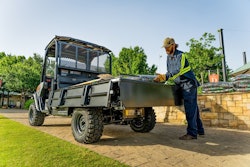Equipment operator Ray Davies didn’t quite know what to think when a 40,000-year-old skull of a wooly rhinoceros appeared in the bucket of his Volvo EC 360 in October. He found the fossil while digging for sand and gravel at a quarry near Staffordshire, England.
“I thought it might be something old because of its depth,” Davies told Volvo Spirit Magazine. “It was buried about two, maybe even three meters deep. But I didn’t think it would be that old. And to be honest, I’d never even heard of a woolly rhino before.”
Davies’ find happens to be one of the most significant recent archeological revelations. The skull, in addition to the rest of the skeleton, constitutes the most complete and best-preserved skeleton of a woolly rhino ever found. Archeologists attribute the preservation to the fact the rhino’s remains froze quickly after it died.
“This is the best example of a woolly rhino I have ever seen,” University of Birmingham, England, archaeologist Gary Coates said. “The bones are exceptionally well preserved — usually, remains have been scavenged by predators and only fragments survive.”
The River Trent in Staffordshire is known to be a site where ice age Woolly Rhinos roamed 50-10,000 years ago. At the Whitemoor Haye Quarry where the Davies rhino was found, three other rhino remains have been excavated, including a specimen that still has plant material fused to its teeth. Archeologists hope to use the plant material to determine what woolly rhinos ate.
“I’ve been working at Whitemoor Haye Quarry for five years and have excavated everything from prehistoric burial grounds to Roman farmsteads, but this find was totally unexpected,” Coates told Volvo Spirit. “It’s the biggest find — in all senses of the word — I’ve ever been involved with.”
After the remains have been cleaned and properly conserved, they will be put on display at London’s Natural History Museum.
The excavation site is currently under archeological research by English Nature to find additional remains. After the study is completed, construction material producer LaFarge Aggregates will continue to extract sand and gravel at the site.





